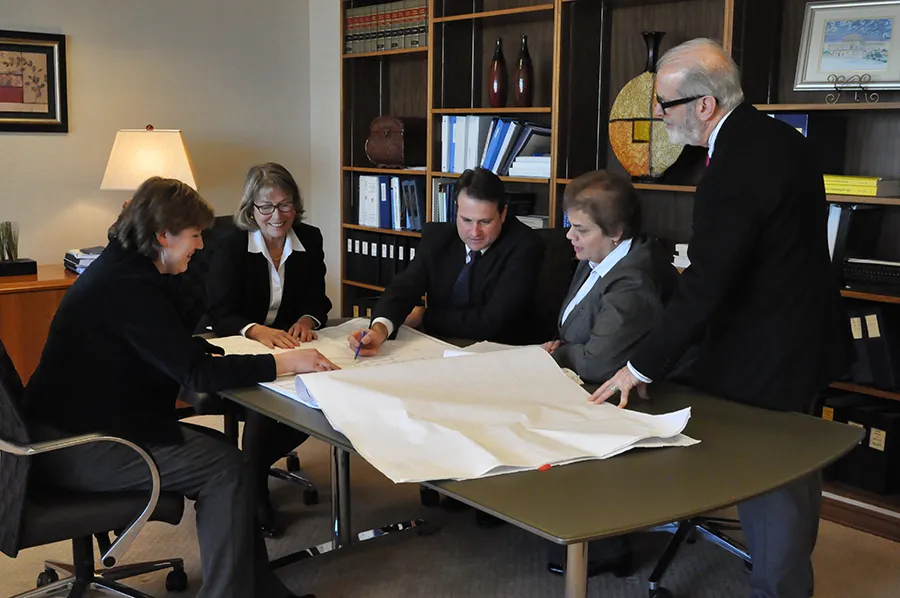
Third Circuit Court staff examine an innovative redesign plan that will enable out-of-town-judges hearing cases in Philadelphia to share chambers space more efficiently. From left are Rebecca Yoder, Interior Designer; Margaret Wiegand, Circuit Executive; Derek Pedersen, Assistant Circuit Executive for Space, Facilities & Security; Antoinette Donovan, Project Manager; and Paul Crum, Space Planner.
The U.S. Court of Appeals for the Third Circuit had a problem. With four appellate judges in its Philadelphia courthouse approaching senior status, there wasn’t enough room to construct chambers for the new judges who would fill their seats.
Faced with a costly plan to expand into an adjoining building, the court instead found a way to better use the space it already had. In an innovative redesign approved by all of the appellate court’s judges, 17 out-of-town judges will share scaled-down chambers when they hear cases in Philadelphia.
“This will take care of all our space needs for the foreseeable future,” said Margaret Wiegand, Third Circuit Court Executive. “If we had had to rent new space in another building, it would have been very expensive.”
The chambers-sharing plan is a local Third Circuit initiative, but it comes amid a national budget crunch that is pressuring federal courts to reduce space and rent. In September, the Judicial Conference set a goal of reducing federal court space 3 percent by the end of Fiscal Year 2018.
Judge D. Brooks Smith views the Philadelphia redesign from two perspectives. As a member of the Third Circuit whose resident chambers are in western Pennsylvania, he personally will share the new chambers space when he sits in Philadelphia. As chair of the Judicial Conference’s Space and Facilities Committee, he oversees national space-reduction efforts.
“In FY 14, unless we receive relief from Congress, the Judiciary will lack the funds to pay its entire rental bill to the General Services Administration. Things are that dire,” Smith said. He added, “I am delighted with the design, which will provide adequate and comfortable space for my staff and me to do our jobs while on the road.”
The Third Circuit occupies five floors in the 22-story James A. Byrne U.S. Courthouse. Five chambers are currently occupied by two active Circuit judges and three senior appeals judges, with two seats currently vacant. Although senior judges hear a reduced number of cases, they continue to need chambers space even after they assume senior status. The building’s remaining floors are occupied by the U.S. District Court for the Eastern District of Pennsylvania, U.S. Marshals Service employees, and other court support operations.
Like other U.S. Courts of Appeals, the Third Circuit hears appellate cases as panels, with judges selected randomly to hear specific cases. The number of out-of-town judges assigned to a panel varies with each case, although judges not based in Philadelphia—which is the court’s primary location—typically travel there six times a year, and sometimes more, to hear cases.
When Circuit staff first examined long-term space needs in 2010, “One non-resident judge commented to staff, almost in an offhanded way, that he really didn’t need all this space in Philadelphia,” Wiegand recalled. “That began a flurry of brainstorming, rethinking and reconfiguring how we house non-resident judges.”
The court will redesign three of the nine chambers currently set aside for non-resident judges. Each will contain four smaller offices—enough to handle 12 out-of-town judges—as well as separate conference rooms. Law clerks will sit in individual workspaces in an open area, instead of at large desks.
The sharing arrangement will allow four other chambers, now dedicated to non-resident judges, to be used for new judges as they are appointed in coming years. Approximately $250,000 in rent will be saved annually by not having to expand, Wiegand said.
The plan gained unanimous approval from the Third Circuit’s appellate judges, including those based in New Jersey, Delaware and other parts of Pennsylvania. “They were very enthusiastic,” said Wiegand, who praised her staff, led by Derek Pedersen, assistant circuit executive for space and facilities. “This really was a staff effort, and the judges very much appreciated the staff’s creativity.”
Judge Smith said that although appellate courts occupy less space than district courts, they will need to review the use of libraries, administrative offices and judges’ chambers. While he is pleased with the Philadelphia redesign, Smith expects courts to come up with their own space-reduction proposals.
“Of course, I wouldn't suggest a ‘one-size-fits-all’ approach to developing space reduction plans,” Smith said. “The Third Circuit's approach works for us. The Space and Facilities Committee will be looking to every circuit and every district for ideas. Innovation is going to result from a combination of ideas that come from local courts and a cooperative spirit that recognizes that the entire federal judicial family must face the challenge of space reduction together.”
Subscribe to News Updates
Subscribe to be notified when the news section is updated.
